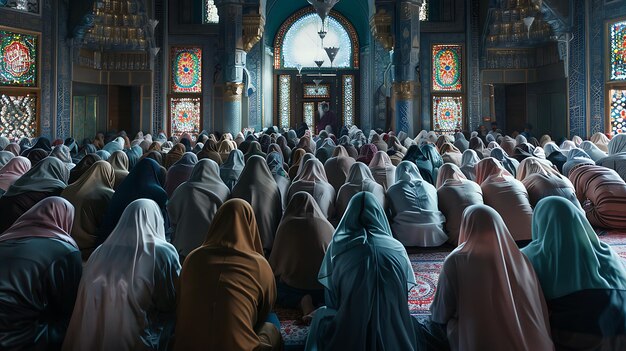From its earliest days, the masjid has served as the vibrant heart of Muslim society—far more than a site for ritual prayer. For Prophet Muhammad ﷺ and his companions, it was the nerve centre for education, governance, justice, social reform, and spirituality. It was a place of empowerment, healing, and community building—open to all, including women.
But somewhere along the way, this inclusive and visionary spirit faded. Today, in many parts of the world, especially in South Asia, masajid have become spaces where women are either sidelined or entirely excluded. What was once a right has become a privilege withheld—misunderstood, misrepresented, and ultimately lost to misinterpretation and cultural conditioning.
At a time of moral crisis, political oppression, and rising threats to religious spaces, it is vital we return to the original blueprint of the masjid and revive it as a space of dignity, justice, and equal participation—especially for women.
A Sacred Right Forgotten
Islam grants women the right to attend masajid—not with compulsion, but with choice and dignity. The Prophet ﷺ categorically stated: “Do not prevent women from going to the masjid.” (Ahmad, Abu Dawud). Yet, in many communities today, cultural fears and unfounded interpretations have turned this right into a restriction.
Women today actively engage in education, business, public service, and politics. To deny them access to the masjid—the very house of Allah—while they frequent every other public space, is not only contradictory but unjust. It also runs counter to both the Qur’anic message and the lived Sunnah of the Prophet ﷺ.
What the Qur’an Says
The Qur’an does not differentiate between men and women when it comes to prayer. Its call—“Hayya ‘ala-s-salaah, Hayya ‘ala-l-falaah” (Come to prayer, come to success)—is universal. The example of Maryam (AS), who grew up in a place of worship under divine care, further strengthens this inclusive model.
If her upbringing within a masjid was improper, the Qur’an would have made it clear. But it didn’t. Instead, it praised her piety and set her as a model for all believers.
The Prophetic Model: Balanced and Inclusive
The Prophet ﷺ not only allowed women into the masjid, but also made arrangements to ensure their comfort and dignity. He asked that women be allowed to leave the masjid first after congregational prayers, protected their privacy, and acknowledged their presence in religious discourse and decision-making.
Aisha RA, Umm Salamah RA, and other women of the era were regular attendees and participants. When a companion’s wife asked about women’s presence in masajid, the Prophet ﷺ did not discourage her. Even in delicate situations, like the crying of a child during prayer, he would shorten the prayer to ease the burden on mothers.
Some opponents of women’s presence quote Aisha RA’s comment that had the Prophet ﷺ witnessed the behavior of some women of later times, he would have stopped them. However, scholars clarify that this was a contextual concern, not a legal verdict. Aisha RA herself continued attending masjid even after making that statement.
The Fear of Fitna – A Misused Argument
While concerns about ‘fitna’ (temptation or discord) are often cited, they are not a valid basis for denying religious rights. The Prophet ﷺ never used fitna as an excuse to bar women. On the contrary, he managed such concerns through guidelines, not exclusion.
Ironically, women today go to offices, courts, and shopping malls—often with less protection than what a masjid can provide. Yet, masajid are closed to them in the name of modesty and morality. This hypocrisy must be addressed.
Reviving the Legacy: From Words to Action
We must move beyond mere discussion and take steps to reintegrate women into the masjid system. This is not about opposing men, but about collaborating to restore the full function of the masjid as a community institution.
A realistic and impactful starting point would be for at least five women in every mohalla to step forward—willing to contribute their time, energy, and skills to community development through the masjid. With the right support, planning, and space, this could revolutionize the role of masajid in just a few years.
This change demands willpower, planning, and strategic resource allocation. It begins with an audit of our current practices and a commitment to rectify them. If there is will, there is always a way.
Masajid in Peril – And Our Response
In today’s climate, masajid themselves are under threat. Across India, there are attempts to confiscate or demolish them, exploiting legal and political mechanisms. In such times, defending the sanctity of these spaces is the duty of all—men, women, elders, youth, and even children.
Let us be clear: Our hope does not lie in those who systematically demonise our community, imprison our youth without trial, incite hatred through speeches, and leave women widowed in the streets. If such forces bring their version of “UMEED”, we must reject it.
Instead, our real guidance and strength lie in the Qur’an and Sunnah—sources that uphold justice, honor, and dignity for every believer, especially women.
Community leaders, if sensitized, are often willing to listen and facilitate change. But it is equally important that women step up—ready to sacrifice, organize, and contribute, understanding that with every right comes responsibility.
Conclusion: Return to the Roots
This is not just about reopening physical doors. It is about reclaiming the spirit of the masjid—as an inclusive, just, and vibrant sanctuary where men and women come together in faith and service. It is about strengthening the Muslim community spiritually, morally, and socially through a return to prophetic principles.
Let us not chase false promises. Let us act with wisdom, sincerity, and unity—drawing strength from our faith and from each other.
(Inputs taken from the original article published in Aura e-Magazine, June 2025, authored by Rahmatunnisa A, National Secretary of Jamaat-e-Islami Hind)




